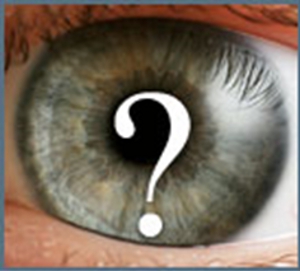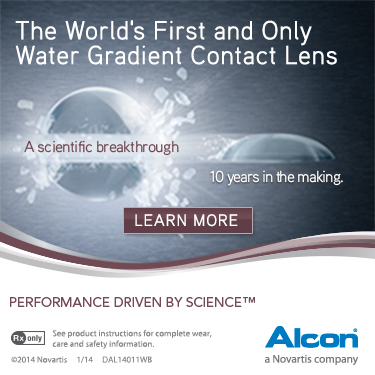

|
It has been noted in several peer reviewed, scientific manuscripts that silicone hydrogel materials in general are associated with at least a two times increase in the frequency of a corneal infiltrate compared with hydrogel materials. To my knowledge, no one silicone hydrogel material has been identified scientifically in this regard. That said, why would silicone hydrogels, with their increased oxygen permeability, be associated with more frequent corneal infiltrates? The question is an intriguing one, and certainly worthy of scholarly study.
|

|
Bausch + Lomb has begun the initial roll-out of its Bausch + Lomb Ultra contact lens with MoistureSeal technology, a new monthly replacement silicone hydrogel contact lens. According to the company’s announcement, the new lens technology, which has been studied and developed for seven years, combines a breakthrough material with new manufacturing processes to produce a contact lens that breaks the cycle of discomfort for unsurpassed comfort and vision all day.1
Bausch + Lomb Ultra contact lenses were formally introduced during the company’s educational initiative for eye care professionals. The all-day training program enabled more than 300 eye care professionals to gain first-hand experience and understanding of the science, technology and patient benefits associated with the new material.
B+L received FDA marketing clearance for the frequent replacement and monthly modality silicone hydrogel contact lenses in September 2013. The Bausch + Lomb Ultra contact lenses are now being distributed in select markets with a national roll-out scheduled for spring 2014.
1. Results from a 22-investigator, multi-site study of Bausch + Lomb contact lenses with MoistureSeal technology, with a total of 380 eligible subjects. After 7 days of wear, subjects completed an online survey. Subjects rated Bausch + Lomb contact lens performance across a range of attributes and compared the performance to their habitual lenses.
|
|
Alden Optical has acquired Fluoresoft-0.35% fluorescent solution from Holles Laboratories, Inc. Fluoresoft-0.35% is the only high molecular weight fluorescent solution available in the US and is used extensively by specialty contact lens practitioners to evaluate the cornea-to-lens fitting relationship. Fluoresoft-0.35 is unique in that the high molecular weight compound prevents absorption by soft lens materials thereby preventing lens staining. Fluoresoft-0.35% is also used to assess epithelial abnormalities due to contact lens wear and during applanation tonometry.
Fluoresoft-0.35% is now available in the United States directly from Alden Optical or through any of the current distributors and wholesalers who have traditionally supplied the product. Those interested can contact Alden directly at 800-253-3669 or email at info@aldenoptical.com. Additionally, all of the existing Holles Laboratories contact information remains valid.
The company intends to pursue distribution in Canada and the European Union by the end of 2014.
.
|
|
Texas-based optometric alliance Vision Source announced the launch of the new redesigned and responsive website, designed by the Internet marketing company, Avelient.
The new website has been designed using the latest technology so the site is compatible with all browsers, tablets, and mobile devices. In addition, the new features aim to provide visitors with an exceptional user experience through its ease-of-use and informative materials. The site includes an improved doctor locator, information about various programs and managed care initiatives, access to Vision Source gear, job listings, an exclusive member marketplace and new educational content through blogs and articles. Additionally there are numerous patient, member and vendor testimonials throughout the site so that everyone can share their experiences and best practices that they have enjoyed at Vision Source practices.
Check out the website at www.visionsource.com.
|
|
The first event of its kind, the Global Contact Lens Forum is the result of a joint partnership agreement between the British Contact Lens Association (BCLA) and the International Vision Expo & Conference. Taking place March 26-27 at the Javits Centre in New York, immediately prior to Vision Expo East 2014, the two-day event will offer world-class continuing education and business lectures jointly devised by the Vision Expo Conference Advisory Board and the BCLA.
Exploring all aspects of contact lens practice business, the COPE-approved program features internationally-renowned speakers such as Professor Lyndon Jones (Canada), who will deliver the keynote address, Nick Rumney (BCLA/UK), Joe Barr (USA), Kirk Smick (USA), Jack Shaeffer (USA) and Shelly Bansal (BCLA/UK).
For program details visit: www.visionexpoeast.com/en/Education/Global-Contact-Lens-Forum.
|
|
AOA members now have access to cyber liability coverage, which helps protect ODs who conduct many business functions online, such as operating a practice website or storing confidential patient records. The latest health care industry data shows that the average cost of recovering from a data breach is $240 per record.1
Joe Ellis, OD, AOAExcel Chairman of the Board and past AOA President is encouraging colleagues to learn more about the new HIPAA regulations that recently went into effect and to consider purchasing cyber liability coverage in light of these new regulations.
Cyber liability coverage includes:
- Expenses related to responding to a major privacy event
- Notification to all parties affected by a security breach
- Potential regulatory fines and defense
- Costs related to ongoing credit monitoring
- Outside investigative costs
Visit www.excelod.com/business-liability or call (888) 343-1998 to learn more about Cyber Liability Insurance, as well as Malpractice Insurance and a Business Owners Policy (BOP) – all specifically designed for optometrists.
To find out more about the new HIPAA regulations, visit www.excelod.com/hipaa.
1. www.indefenseofdata.com/data-breach-trends-stats/
Insurance Program Administered by Lockton Affinity, LLC.
|

|
|

|
|

Have you seen an interesting case lately? Would you like to share it with your colleagues? An image from that case could appear in this column in the coming weeks!
We welcome photo submissions from our readers! It is easy to submit a photo for consideration for publishing in Contact
Lenses Today. Simply visit
http://www.cltoday.com/upload/upload.aspx to upload your image. Please
include an explanation of the photo and your full name, degree or title and city/state/country
^ Back to top
|

|
Are you techy?
Technology is fascinating. One of the greatest things about it is that it is always improving, always advancing, and ever changing. Today is another first for me. I am writing this column on my iPhone while traveling to lecture on dry eye and contact lens technology. Yes I have a laptop and iPad with me, but it is more impactful that I'm typing with one thumb – not that many years ago, this technology option was not available.
At the recent Global Specialty Lens Symposium, I was among the 500 eye care practitioners who had the opportunity to hear about and try out the latest and greatest advancements from our industry partners. I'm constantly enthralled and amazed at how the big manufacturers keep advancing with materials and designs yet niche labs are pushing the envelope. In the next two months, this column will bring you some of the latest industry buzz. I know I'll miss some new developments, but please tweet me (@davekading) the advances you are seeing that you think I should cover. I'm excited for the future and I hope you are too. Enriching lives is why we do what we do. Happy fitting.
^ Back to top
|
|
Corneal Power Changes in Corneal Reshaping (Ortho-K) – Key to Myopia Stabilization?
A study was conducted to discover if there was a relationship between the magnitude of corneal refractive power change following corneal reshaping treatment (orthokeratology) and axial length elongation in children.
Thirty-two children ages 9 to 14 were fit into corneal reshaping (Ortho-K) lenses. Following stabilization of the corneal reshaping effect, 3 month topographic data was obtained and analyzed. Corneal refractive powers along the nasal, temporal, and inferior axes were collected over an 8-mm-diameter ring in 1-mm steps using the sagittal power map. Axial length (AL) was measured every 6 months during a 24-month period. The relationship between the maximum power changes and 2-year axial elongation were analyzed.
Changes in corneal refractive power significantly affected axial elongation (nasal, p = 0.001; temporal, p = 0.011; inferior, p = 0.001). Two-year axial elongation in patients with larger corneal power changes was reduced by 54% to 69% compared with those with smaller corneal power changes. Maximum power changes along the three axes were negatively correlated (p < 0.05) with 2-year axial elongation.
The researchers concluded that subjects with a larger magnitude of corneal relative peripheral power change after corneal reshaping treatment experienced slower axial elongation by the end of 24 months. This effect might be mediated by the induction of greater amount of relative myopic defocus on the peripheral retina. These results could influence future designs of both corneal reshaping and multifocal soft contact lenses intended for myopia stabilization where greater degrees of peripheral relative steepening for corneal reshaping and greater peripheral add powers for soft multifocals would be desirable.
Zhong Y, Chen Z, Xue F, Zhou J, Niu L, Zhou X. Corneal Power Change Is Predictive of Myopia Progression in Orthokeratology. Optom Vis Sci. 2014 Jan 31 [Epub ahead of print]
^ Back to top
|

|

|
|
Corneal Topographic and Tomographic Analysis of Fellow Eyes in Unilateral Keratoconus Patients Using Pentacam
|
|
The purpose of this retrospective comparative case series was to evaluate topographic and tomographic changes in fellow eyes in unilateral keratoconus (KCN) patients by comparing them with normal eyes.
Fourteen eyes of 14 patients with unilateral KCN and 34 eyes of 34 refractive surgery candidates were divided into three diagnostic groups using a Pentacam rotating Scheimpflug camera: advanced KCN eyes of unilateral KCN (KCN group, 14 eyes), normal fellow eyes of unilateral KCN (fellow eye group, 14 eyes), and refractive surgery candidates (normal group, 34 eyes). Topographic and tomographic parameters, which were obtained from Pentacam using sagittal curvature, elevation, and corneal thickness maps, were compared among the three groups. Receiver operating characteristic (ROC) curves were used to identify cutoff points in discriminating between fellow and normal eyes.
Keratometric asymmetry, topometric indices, and elevation differences (maximum - minimum) on both the anterior and posterior surfaces were statistically different (P < .05). On ROC curve analysis, keratometric asymmetry and topometric index were best at discriminating fellow eyes from normal, followed by elevation differences (maximum - minimum) on the posterior and anterior cornea surface.
The authors concluded that fellow eyes in unilateral KCN showed differences in several parameters that were not detectable with the Pentacam detection program, when compared with normal. However, each single parameter alone is not sufficient to detect early changes; thus, elevation indices as well as indices of anterior curvature should be considered together.
Bae GH,Kim JR,Kim CH,Lim DH,Chung ES,Chung TY. Corneal topographic and tomographic analysis of fellow eyes in unilateral keratoconus patients using pentacam. Am J Ophthalmol. 2014 Jan;157(1):103-109.e1. Epub 2013 Oct 25.
|
|
|

|
|
A Proud Supporter of

Important Links:
To report adverse contact lens reactions visit:
http://www.accessdata.fda.gov/scripts/medwatch/ or call (800) FDA-1088.
To report possible grievances related to the Fairness to Contact Lens Consumers
Act or associated Contact Lens Rule visit:
https://www.ftccomplaintassistant.gov/.
CLToday Services:
Subscribe;
Unsubscribe; Submit Clinical
Image
Submit news to cltoday@pentavisionmedia.com.
Send your comments and fitting tips to
cltoday@pentavisionmedia.com. Please include your full name, degree or title
and city/state/country.
For more information on Contact Lenses Today including archives of previous
issues, please visit our website at www.cltoday.com.
For the latest articles on contact lenses, important clinical information and helpful
tools related to the contact lens practice visit the Contact Lens Spectrum
website at www.clspectrum.com.
© 2024 All Rights Reserved Contact Lenses Today and CLToday
are registered trademarks of:
PentaVision LLC, 321 Norristown Road, Suite 150, Ambler, PA 19002 | 215-646-8700
© 2024 PentaVision LLC All Rights Reserved.
|

|
|
|



















